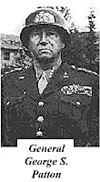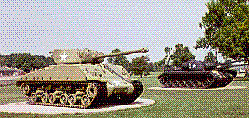FIELDS OF ARMOR
 The Patton Museum is located at Ft. Knox, Kentucky, southwest of Louisville. It was another of my travel destinations in the mid-seventies, when the facility was still under construction. Then, the museum had an impressive collection of tanks and other armored vehicles dating back to World War I. Because of a shortage of space, most were displayed outdoors on an expansive, rolling lawn. Inside, the building housed the definitive collection of George Smith Patton memorabilia, including the famous Colt revolvers. When I made my sojourn into the midwest in September 1997, I put the Patton Museum onto my itinerary.
The Patton Museum is located at Ft. Knox, Kentucky, southwest of Louisville. It was another of my travel destinations in the mid-seventies, when the facility was still under construction. Then, the museum had an impressive collection of tanks and other armored vehicles dating back to World War I. Because of a shortage of space, most were displayed outdoors on an expansive, rolling lawn. Inside, the building housed the definitive collection of George Smith Patton memorabilia, including the famous Colt revolvers. When I made my sojourn into the midwest in September 1997, I put the Patton Museum onto my itinerary.
Similar to my visit to the Air Force Museum, I was immediately struck with an important change over the past twenty-five or so years. Two, actually. First, the building was finished, and had been for over two decades. The other was that the outdoor tank collection was almost completely gone. There were a few left in front of the building, but most of the land formerly taken up with armored vehicles was now dedicated to a memorial park, similar in intent, to the Air Force Museum's, commemorating US Army tank units of World War II.
 This park is far more homogeneous than the one at the other service's installation. This is a coherently planned and stylistically uniform effort, incorporating monuments to smaller units placed in circles according to parent division. Paths lead from group to group, taking the visitor on a tour of armor's Second World War history and order of battle.
This park is far more homogeneous than the one at the other service's installation. This is a coherently planned and stylistically uniform effort, incorporating monuments to smaller units placed in circles according to parent division. Paths lead from group to group, taking the visitor on a tour of armor's Second World War history and order of battle.
It seems to be the tribute of an organization to itself and its fallen. No less sincere, or worthy for it, but still a fairly sterile and intellectualized official committee effort. On the other hand, the melange of monuments at the Air Force Museum appears as the heartfelt tribute of small groups and The Army monuments stand at attention; the Air Force ones tell stories.
The Air Force Museum, near Dayton and accessible from major highways, is a very popular and fairly crowded installation. It is alive. The Patton Museum's location is distant enough from both city and interstate that it takes some effort to go there, and there is little if any impulse traffic there. Thus it seems fairly lifeless. It is a gloomy place. Upkeep appears less enthusiastic than at the Air Force Museum; the day of my visit, the smell and feel of humidity, old carpet, and inadequate air conditioning was striking. In addition, some of the exhibit halls could use both new carpeting and a fresh coat of paint.
Many of the tanks once displayed outside are now inside. But some are missing, and the exhibits tend toward dreariness. For example, a rare example of a British-built Mark IV heavy tank from World War I is located in a cramped enclosure that prevents one from seeing the whole vehicle at once. The halls themselves are dark and dim. Illumination comes from track lighting and spot lights and, even though none has the flat black paint of the Air Force Museum's older half, it just seems darker and more depressing.
The vehicles on exhibit are chiefly from World War II. Strangely Desert Storm, the greatest expression of American mechanized might, is badly neglected. The sole vehicle from that conflict is a T-72, captured from Saddam's army, and painted in Republican Guard colors. Yet the museum badly neglects American armor of the period. Outside, as casually exhibited and inadequately interpreted as the other forlorn relics there, stands a prototype of the XM1. But by and large, the contemporary US Army and the victory in the Gulf remain a couple of great blanks in the Patton Museum's attention.
Then there is Patton himself, the man and the legend. His life is also the museum's best area of coverage. It begins with his youth, but centers on his career as a soldier. The Patton Museum displays weapons he owned, in addition to those revolvers, including a cavalry saber he designed. It also has his medals, command truck, and even the car (since repaired) in which he was mortally injured. The interpretation as well is greatly superior to that typical of the tank collection; it might not dwell on Patton's more obnoxious eccentricities, but it does give a very good view of this complex commander.
Rounding out the museum are some rather curious items. There is a small display on the Civil War Battle of Perryville. One has to ask, why? It took place in Kentucky, and not all that far from Ft. Knox, but had obviously little to do with the museum's prime foci, tanks and George S. Patton.
More appropriate, though surprising, is something that has everything to do with Ft. Knox, but absolutely no connection to armor or the general. It is a model of the gold depository, crafted for the James Bond movie Goldfinger.
CONCLUSIONS
The United States Air Force Museum and the Patton Museum are studies in contrast. The former functions clearly as a showcase for the United States Air Force. It incorporates one of the greatest, if not the greatest, collection of combat aircraft anywhere, in any country. As a sign of the pride that the museum has in it, the bookstore offers a catalogue that may well be the best souvenir to be had in any museum. It is an extensive directory of the planes on exhibit, including not just pictures and technical specifications, but the history and provenance of individual examples on display. Not to be neglected, it is huge. It takes at least two days now to make a really comprehensive and satisfying visit. Furthermore, it promises to grow even more; one staff member told me that there were very firm plans to add a third building to the already massive complex within a few years. As it stands currently, it is one of the best museums that the historically-inclined traveler can possibly tour. In fact, it positively demands repeat visits.
On the other hand, the Patton Museum can be fully toured in a morning or afternoon. Unfortunately, it is a case of misfires and missed opportunities. The Patton Museum is decidedly less abundantly funded, thoughtfully planned, and diligently maintained. Considering its relatively isolated location, it will undoubtedly never admit the mass of visitors destined for its Air Force counterpart to the north. But it is shameful that its sponsors do not make a stronger effort at making it the destination that it might be.
Museum Introduction
United States Air Force Museum
Back to Cry Havoc #24 Table of Contents
Back to Cry Havoc List of Issues
Back to MagWeb Master Magazine List
© Copyright 1998 by David W. Tschanz.
This article appears in MagWeb (Magazine Web) on the Internet World Wide Web. Other military history articles and gaming articles are available at http://www.magweb.com